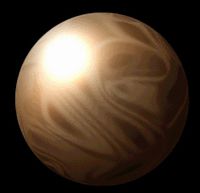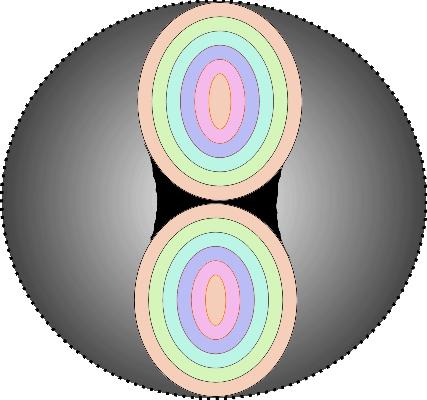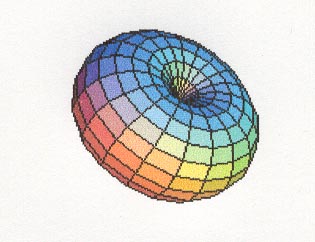Hypatia
Hypatia is the name given to the 5-D spherical body
around which the brane of our universe is wrapped. The 4-D brane
manifests locally as hyperbolically curved space, modelled by the
interior of a sphere which tightly contains a torus (donut) with a
zero-sized central hole; the torus is excised from the sphere's interior
and the observer is placed at the origin (center) of the sphere. The
remaining volume within the sphere represents our hyperbolically curved
space, by which if we travel a characteristic distance R, the area of
the shell of space reachable is not the 4?R² of flat Euclidean space,
but rather 4?R²/(1-R²/T²)² (approx) , where T is the maximum possible
distance. Thus our universe is finite but unbounded, and negatively
curved.
Why
such a model? 100 years ago Einstein took an apparently absurd
observation, the invariant speed of light, and turned it into a theorem
which revolutionised our knowledge of physical law. Today, too, we have
observations, notionally absurd, but which point the way to further
understanding. These observations are:
- The
linear relationship between redshift and angular size. At high
redshift this linearity should break down but does not.
- The
distance problem that there are more bright objects at high distance
than allowed for by standard flat (Euclidean) geometry.
- Similarly,
that "nearby" objects (z<0.5) are fainter than expected, resulting
in a "accelerating expansion" model of the Big Bang.
- The
horizon problem that conditions were similar long ago in very
different parts of the universe.
- Gravity
remains un-unified with the rest of physical law. Altho modelled
geometrically, its origin remains unknown.
- Oft
overlooked due to familiarity: the absurdity of a model in which
things are flying apart from eachother at high speed.
The
Hypatia model of the universe elegantly accomodates all these
observations.
|
A
5-D sphere, rounder than we know, Hypatia is an
ecosystem of which its undulating surface, our universe, is a
bit player.

|
Divergent
geometry of the hyperbolic space goes as the
surface of a torus of zero aperture, from its center. Einstein
modelled such a curvature as part of his static universe, but
extended it outwards a brief way without closing the curve by
wrapping it around the torus, as do the radial lines (emanating
from the centre) in this illustration (right).
|
|
 |
Motion
thru the manifold is modelled by the observer
remaining at the center and the torus flexibly rotating thru its
centre; thus the spatial curvature remains unchanged regardless
of the observer's travels. In this illustration (left), leftward
travel involves the upper limb of the torus turning
counter-clockwise and the lower limb turning clockwise, in
tandem.
|
How
does the Hypatia model reconcile the observations
presented on this page?
- Cosmological
redshift is intepreted as the difference in rate of time flow
between past and present.
- Hyperbolic
spatial curvature accomodates a greater population at large
distances. and causes "nearby" (z<.5) objects to appear
dimmer than expected..
- Changing
time rates and other conditions emanating from Hypatia's
center allows changes to occur uniformly throughout our
universe.
- Gravity
originates within Hypatia, so is external to our universe.
Topological undulations create differential gravity zones in
our universe, causing supercluster great walls & voids,
explaining galactic rotational profiles, etc.
- There
is no need for a big bang and the universe is eternal, i.e.
time is a condition local to the universe.
|
This
page does not try to explain too much. A key point is that the
rate of time flow (originating, like gravity, from Hypatia) increases
with the passage of time. It is a derivative function only, and serves
to distinguish past and present. This is interpreted in the big-bang
cosmology as physical expansion. But time is a more sensible candidate
for change than physical size, as was known for the first 20 years after
the redshift was discovered. The 5D curvature means that photons
crossing between dissimilar places (i.e. different 5D hyperangle) will
impact with a vector component pointing back to Hypatia -- thus a
fraction of them disappear from our universe. This accounts for the
"missing Solar neutrinos" problem. Another key point is that matter
recycles out and in of our universe; black holes represent the exiting
of high-entropy matter out of our universal brane back to Hypatia, and
young galaxy centers and quasars represent the re-introduction of
low-entropy matter back into our universe from Hypatia -- they are
gravitational towers from which matter falls into our universe, and
double radio lobes also appear to be matter "falling" out of galaxies'
poles via 5D gravitational slopes. Black holes do the same but are
gravitational funnels exiting to 5-D Hypatia and so are very dim of
course.
Want
hard math? Look at this paper by Ichiki, Garnavich et al which describes the salient
points. For an early non-mathematical description see
this January 1998 posting done by your correspondent, after I saw
all this during a Xmas-New Year holiday at a New Zealand South Island
holiday house overlooking the Pacific. Through the sound of crashing
waves I saw only the dimensions, the gravity, the quasars, the geometry
and the math -- but pardon the prose (both here and in this posting
titled "Odyssey to Hypatia"
).


